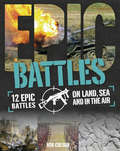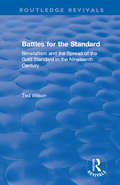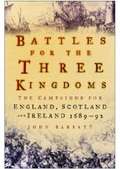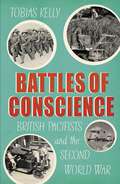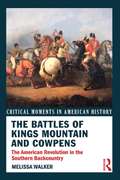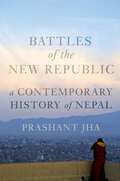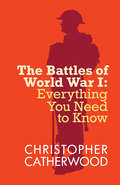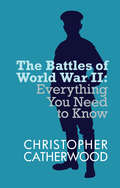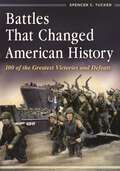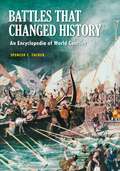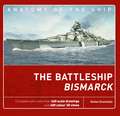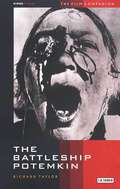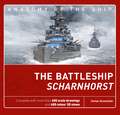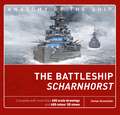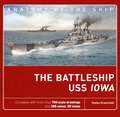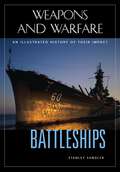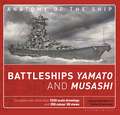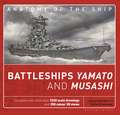- Table View
- List View
Battles: Battles (library Ebook) (Epic! #2)
by Rob ColsonEpic: Battles focuses on 12 of the biggest and most brutal battles in the history of the world, from Thermopylae in 480 BCE right the way through to Operation Desert Storm in 1991, taking in Cannae, Agincourt, Lepanto, the Siege of Yorktown, Trafalgar, Waterloo, Gettysburg, the Somme, the Battle of Britain and the Siege of Stalingrad. The book details the date and location of each battle, the opposing forces involved and the casualties resulting. A timeline on every spread gives the key dates from each battle, and what happened when. Additional background information to each conflict is also provided, including the Punic Wars, the Hundred Years' War, the American Revolution, the Napoleonic Wars, the American Civil War, World War 1, World War 2 and the first Gulf War.Epic: Battles also looks at the technology, tactics and weaponry involved in each battle, from the longbow at Agincourt and the galleasses at Lepanto to the trench warfare of the Somme and the stealth fighter jets of the Gulf War.Infographic elements on each spread present information in a simple and highly visual way. Clear, concise text and a bright, appealing design make the book the perfect resource for project work on battles, warfare and military history, or simply a great leisure read, for children aged 9 and above.For more epic events, try reading the other titles in the Epic series: Animal Migrations, Empires and Explorers.
Battles for Freedom: The Use and Abuse of American History
by Eric FonerIn thiscollection of polemical pieces, Foner expounds on the relevance ofAbraham Lincoln's legacy in the age of Obama and on the need foranother era of Reconstruction. In addition to articles in which Fonercalls out politicians and the powerful for their abuse and misuseof American history, Foner assesses some of his fellow leadinghistorians of the late 20th century, including Richard Hofstadter,Howard Zinn and Eric Hobsbawm. Foner ends with an open letterto Bernie Sanders analysing the great tradition of radicalism thathe has spent his career studying and which, he argues, Americansof progressive disposition should seek to celebrate and retrieve.
Battles for Freedom: The Use and Abuse of American History
by Eric FonerFor almost four decades, Eric Foner, one of America's most distinguished historians, has introduced readers of his journalism to unknown or forgotten characters in American history, methodically unearthing the hidden history of American radicalism. In this collection of polemical pieces, Foner expounds on the relevance of Abraham Lincoln's legacy in the age of Obama and on the need for another era of Reconstruction. In addition to articles in which Foner calls out politicians and the powerful for their abuse and misuse of American history. Foner assesses some of his fellow leading historians of the late 20th century, including Richard Hofstadter, Howard Zinn and Eric Hobsbawm. Foner ends with an open leter to Bernie Sanders analysing the great tradition of radicalism that he has spent his career studing and which, he argues, Americans of progressive disposition should seek to celebrate and retrieve.
Battles for the Standard: Bimetallism and the Spread of the Gold Standard in the Nineteenth Century (Routledge Revivals)
by Ted WilsonThis title was first published in 2000. This is a history of the monetary developments in the international economy of the 19th century. It reviews the monetary developments in the core economies of the period: Britain, the United States, France, Germany, and also India. Particular attention is given to the expansion of the gold standard in the context of the intense national and international debates about the role of precious metals and the author also examines the conflict between supporters of gold, silver and bimetallism, both in terms of competing financial and economic theories and in terms of the varying social and cultural backgrounds that informed them. The main thrust of the work is that the sheer plurality of ideas and contexts helped to ensure the eventual victory of the gold standard, despite the inherent superiority of bimetallic systems.
Battles for the Standard: Bimetallism and the Spread of the Gold Standard in the Nineteenth Century (Routledge Revivals)
by Ted WilsonThis title was first published in 2000. This is a history of the monetary developments in the international economy of the 19th century. It reviews the monetary developments in the core economies of the period: Britain, the United States, France, Germany, and also India. Particular attention is given to the expansion of the gold standard in the context of the intense national and international debates about the role of precious metals and the author also examines the conflict between supporters of gold, silver and bimetallism, both in terms of competing financial and economic theories and in terms of the varying social and cultural backgrounds that informed them. The main thrust of the work is that the sheer plurality of ideas and contexts helped to ensure the eventual victory of the gold standard, despite the inherent superiority of bimetallic systems.
Battles for the Three Kingdoms: The Campaigns for England, Scotland and Ireland 1689-92
by John BarrattThe Battle of the Boyne in 1690 was the culmination of the ferocious struggle between two kings, James II and William III. This book makes use of research and sources, including eyewitness accounts, to analyse the opposing forces, their strategy, tactics and conduct of the war and the reasons for its eventual outcome.
Battles of Conscience: British Pacifists and the Second World War
by Tobias KellyA ground-breaking new study brings us a very different picture of the Second World War, asking fundamental questions about ethical commitmentsAccounts of the Second World War usually involve tales of bravery in battle, or stoicism on the home front, as the British public stood together against Fascism. However, the war looks very different when seen through the eyes of the 60,000 conscientious objectors who refused to take up arms and whose stories, unlike those of the First World War, have been almost entirely forgotten.Tobias Kelly invites us to spend the war five of these individuals: Roy Ridgway, a factory clerk from Liverpool; Tom Burns, a teacher from east London; Stella St John, who trained as a vet and ended up in jail; Ronald Duncan, who set up a collective farm; and Fred Urquhart, a working-class Scottish socialist and writer. We meet many more objectors along the way -- people both determined and torn -- and travel from Finland to Syria, India to rural England, Edinburgh to Trinidad.Although conscientious objectors were often criticised and scorned, figures such as Winston Churchill and the Archbishop of Canterbury supported their right to object, at least in principle, suggesting that liberty of conscience was one of the freedoms the nation was fighting for. And their rich cultural and moral legacy -- of humanitarianism and human rights, from Amnesty International and Oxfam to the US civil rights movement -- can still be felt all around us. The personal and political struggles carefully and vividly collected in this book tell us a great deal about personal and collective freedom, conviction and faith, war and peace, and pose questions just as relevant today: Does conscience make us free? Where does it take us? And what are the costs of going there?
The Battles of Kings Mountain and Cowpens: The American Revolution in the Southern Backcountry (Critical Moments in American History)
by Melissa A. WalkerThe American South is so identified with the Civil War that people often forget that the key battles from the final years of the American Revolution were fought in Southern states. The Southern backcountry was the center of the fight for independence, but backcountry devotion to the Patriot cause was slow in coming. Decades of animosity between coastal elites and backcountry settlers who did not enjoy accurate representation in the assemblies meant a complex political and social milieu throughout this turbulent time. The Battles of Kings Mountain and Cowpens brings to light the world of the Southern backcountry that engendered its role in the Revolutionary War. With careful attention to political, social, and military history, Walker concentrates on the communities and events not typically covered in books on the Revolutionary War. Through government documents, autobiographies, correspondence, and diaries, The Battles of Kings Mountain and Cowpens gives students of the Revolution an important new perspective on the role of the South in the resolution of the fighting.
The Battles of Kings Mountain and Cowpens: The American Revolution in the Southern Backcountry (Critical Moments in American History)
by Melissa A. WalkerThe American South is so identified with the Civil War that people often forget that the key battles from the final years of the American Revolution were fought in Southern states. The Southern backcountry was the center of the fight for independence, but backcountry devotion to the Patriot cause was slow in coming. Decades of animosity between coastal elites and backcountry settlers who did not enjoy accurate representation in the assemblies meant a complex political and social milieu throughout this turbulent time. The Battles of Kings Mountain and Cowpens brings to light the world of the Southern backcountry that engendered its role in the Revolutionary War. With careful attention to political, social, and military history, Walker concentrates on the communities and events not typically covered in books on the Revolutionary War. Through government documents, autobiographies, correspondence, and diaries, The Battles of Kings Mountain and Cowpens gives students of the Revolution an important new perspective on the role of the South in the resolution of the fighting.
Battles of the New Republic: A Contemporary History of Nepal
by Prashant JhaBattles of the New Republic: A Contemporary History of Nepal is a story of Nepal's transformation from war to peace, monarchy to republic, a Hindu kingdom to a secular state, and a unitary to a potentially federal state. Part-reportage, part-history, part-analysis, part-memoir, and part-biography of the key characters, the book breaks new ground in political writing from the region. With access to the most powerful leaders in the country as well as diplomats, it gives an unprecedented glimpse into Kathmandu's high politics. But this is coupled with ground-level reportage on the lives of ordinary citizens of the hills and the plains, striving for a democratic, just and equitable society. It tracks the hard grind of political negotiations at the heart of the instability in Nepal. It traces the rise of a popular rebellion, its integration into the mainstream, and its steady decline. It investigates Nepal's status as a partly-sovereign country, and reveals India's overwhelming role. It examines the angst of having to prove one's loyalties to one's own country, and exposes the Hindu hill upper-caste dominated power structures. Battles of the New Republic is a story of the deepening of democracy, of the death of a dream, and of that fundamental political dilemma - who exercises power, to what end, and for whose benefit.
Battles of the New Republic: A Contemporary History of Nepal
by Prashant JhaBattles of the New Republic: A Contemporary History of Nepal is a story of Nepal's transformation from war to peace, monarchy to republic, a Hindu kingdom to a secular state, and a unitary to a potentially federal state. Part-reportage, part-history, part-analysis, part-memoir, and part-biography of the key characters, the book breaks new ground in political writing from the region. With access to the most powerful leaders in the country as well as diplomats, it gives an unprecedented glimpse into Kathmandu's high politics. But this is coupled with ground-level reportage on the lives of ordinary citizens of the hills and the plains, striving for a democratic, just and equitable society. It tracks the hard grind of political negotiations at the heart of the instability in Nepal. It traces the rise of a popular rebellion, its integration into the mainstream, and its steady decline. It investigates Nepal's status as a partly-sovereign country, and reveals India's overwhelming role. It examines the angst of having to prove one's loyalties to one's own country, and exposes the Hindu hill upper-caste dominated power structures. Battles of the New Republic is a story of the deepening of democracy, of the death of a dream, and of that fundamental political dilemma - who exercises power, to what end, and for whose benefit.
The Battles of World War I (Everything You Need to Know)
by Christopher CatherwoodOur understanding of the twentieth century and beyond hinges upon the First World War. In this new and comprehensive book, the fascinating facts are presented in an accessible way, allowing anyone to brush up on the devastating conflict that changed the world we live in. Discover everything you need to know about: The battle of Ypres The Somme The forgotten wars between Italy, Austria and Russia The invention of the tank and how it changed the war The role of the USA The siege of Kut The battle the Germans won and much more . . .
The Battles of World War II: Everything You Need to Know Series (Everything You Need to Know Series #2)
by Christopher CatherwoodThe Second World War is without parallel in human history. The sheer carnage is staggering, with some estimating over 80 million people died as a result of the conflict. Catherwood brings an objective, informative voice to the vast detail on the subject of the war’s key battles, allowing you appreciate how it shaped the world we live in today. Discover everything you need to know about: The prelude to war, The Battle of Britain, The USA’s entry into the war, The Battle of Stalingrad, The Battles in Asia; Iwo Jima, Hiroshima and Nagasaki and much more.
Battles That Changed American History: 100 of the Greatest Victories and Defeats
by Spencer C. TuckerA fascinating and informative analysis by a distinguished military historian of the 100 most influential battles in American history, presented in an accessible, ready-reference format.The Battle of Okinawa (April–June 1945) resulted in more U.S. Navy casualties than all of the navy's previous wars combined; these heavy casualties influenced the decision to employ the atomic bomb against Japan that August. This is just one of many instances in American military history when the outcome of a battle helped to establish the course of history—the focus of this latest encyclopedia from esteemed historian Spencer C. Tucker. The 100 battles spotlighted in this work—which include defeats as well as victories—are deemed to have had the greatest impact on American history. Spanning more than 500 years of military events, the book begins its coverage with the Battle of Mabila in 1540 during the Age of Discovery and ends with the Second Battle of Falluja during the Iraq War/Insurgency in 2004. Expertly written, informative, and thoughtful, this analysis will be insightful and interesting for all high school, undergraduate, and general readers.
Battles That Changed American History: 100 of the Greatest Victories and Defeats
by Spencer C. TuckerA fascinating and informative analysis by a distinguished military historian of the 100 most influential battles in American history, presented in an accessible, ready-reference format.The Battle of Okinawa (April–June 1945) resulted in more U.S. Navy casualties than all of the navy's previous wars combined; these heavy casualties influenced the decision to employ the atomic bomb against Japan that August. This is just one of many instances in American military history when the outcome of a battle helped to establish the course of history—the focus of this latest encyclopedia from esteemed historian Spencer C. Tucker. The 100 battles spotlighted in this work—which include defeats as well as victories—are deemed to have had the greatest impact on American history. Spanning more than 500 years of military events, the book begins its coverage with the Battle of Mabila in 1540 during the Age of Discovery and ends with the Second Battle of Falluja during the Iraq War/Insurgency in 2004. Expertly written, informative, and thoughtful, this analysis will be insightful and interesting for all high school, undergraduate, and general readers.
Battles that Changed History: An Encyclopedia of World Conflict
by Spencer C. TuckerThis encyclopedic collection of more than 200 of the most decisive and important battles throughout world history gets a fresh interpretation by a noted military historian.The mythic and doomed stand of the 300 Spartans at Thermopylae; the siege of Carthage in 149-146 BCE, which ended with Rome destroying the city and enslaving the entire remaining Carthaginian population; the Battle of Hastings in 1066, arguably the most important battle ever on English soil; the Battle of Trenton that saved the American Revolutionary cause and established the military reputation of General Washington; the firebombing of Tokyo on the night of March 9-10, 1945, that destroyed one quarter of the city.All of these conflicts—and hundreds more—played a crucial role in defining the direction of history and the evolution of human society. This text provides high school-level readers with detailed descriptions of the battlefield actions that have played the greatest parts in shaping military history and human existence. Special attention is paid to the greater historical context and significance of each battle, especially in relation to other events.
The Battleship Bismarck (Anatomy of The Ship #1)
by Stefan DraminskiThe Bismarck is perhaps the most famous – and notorious - warship ever built. Completed in 1941, the 45,000-ton German battleship sunk HMS Hood, the pride of the British Navy, during one of the most sensational encounters in naval history. Following the sinking, Bismarck was chased around the North Atlantic by many units of the Royal Navy. She was finally dispatched with gunfire and torpedoes on 27 May, less than five months after her completion. Her wreck still lies where she sank, 4,800m down and 960km off the west coast of France. Drawing on new research and technology, this edition is the most comprehensive examination of Bismarck ever published. It includes a complete set of detailed line drawings with fully descriptive keys and full-colour 3D artwork, supported by technical details, photographs and text on the building of the ship and a record of the ship's service history.
The Battleship Potemkin: The Film Companion (KINOfiles Film Companion)
by Richard TaylorThought by many to be the greatest film ever made, 'The Battleship Potemkin' directed by Sergei Eisenstein is a key film in the history of Russian and of world cinema. Based on a mutiny in Odessa during the 1905 Revolution, the film is noted as a pioneering milestone in the development of world cinema - especially Eisenstein's breathtaking editing. Richard Taylor is a major authority on Eisenstein and his lively companion to Potemkin will be widely welcomed.This _KINOfile_ investigates the production, context and critical reception of the film and the people who made it, and provides an analysis of the film itself and its place in Russian and world cinema.
The Battleship Scharnhorst (Anatomy of The Ship)
by Stefan DraminskiThe Kriegsmarine's Scharnhorst was a German capital ship, described either as a battleship or battlecruiser, and the lead ship of her class, which included one other ship, Gneisenau. She was launched on 3 October 1936 and completed in January 1939, armed with nine 28cm C/34 guns in three triple turrets. She operated with Gneisenau for much of the early portion of World War II, including sorties into the Atlantic to raid British merchant shipping. They took part in Operation Weserübung (April–June 1940), the German invasion of Norway, during which they sank the aircraft carrier HMS Glorious and her escort destroyers Acasta and Ardent. Scharnhorst also sank HMS Rawalpindi in November 1939. In early 1943, Scharnhorst joined the Tirpitz in Norway to intercept Allied convoys to the Soviet Union. On a sortie from Norway to attack a convoy, the German force was intercepted by British ships and during the Battle of the North Cape (26 December 1943), HMS Duke of York and her escorts sank Scharnhorst. Most of her crew was lost. This is the most comprehensive examination of Scharnhorst ever published, drawing on new research and technology to tell the full story of the ship. It includes a complete set of detailed line drawings with fully descriptive keys and full-colour 3D artwork, supported by technical details, photographs, and text on the building of the ship, as well as a record of her service history.
The Battleship Scharnhorst (Anatomy of The Ship)
by Stefan DraminskiThe Kriegsmarine's Scharnhorst was a German capital ship, described either as a battleship or battlecruiser, and the lead ship of her class, which included one other ship, Gneisenau. She was launched on 3 October 1936 and completed in January 1939, armed with nine 28cm C/34 guns in three triple turrets. She operated with Gneisenau for much of the early portion of World War II, including sorties into the Atlantic to raid British merchant shipping. They took part in Operation Weserübung (April–June 1940), the German invasion of Norway, during which they sank the aircraft carrier HMS Glorious and her escort destroyers Acasta and Ardent. Scharnhorst also sank HMS Rawalpindi in November 1939. In early 1943, Scharnhorst joined the Tirpitz in Norway to intercept Allied convoys to the Soviet Union. On a sortie from Norway to attack a convoy, the German force was intercepted by British ships and during the Battle of the North Cape (26 December 1943), HMS Duke of York and her escorts sank Scharnhorst. Most of her crew was lost. This is the most comprehensive examination of Scharnhorst ever published, drawing on new research and technology to tell the full story of the ship. It includes a complete set of detailed line drawings with fully descriptive keys and full-colour 3D artwork, supported by technical details, photographs, and text on the building of the ship, as well as a record of her service history.
The Battleship USS Iowa (Anatomy of The Ship)
by Stefan DraminskiUSS Iowa (BB-61) was the lead ship in one of the most famous classes of battleships ever commissioned into the US Navy. Transferred to the Pacific Fleet in 1944, the Iowa first fired her guns in anger in the Marshall Islands campaign, and sunk her first enemy ship, the Katori. The Iowa went on to serve across a number of pivotal Pacific War campaigns, including at the battles of the Philippine Sea and Leyte Gulf. The ship ended the war spending several months bombarding the Japanese Home Islands before the surrender in August 1945.After taking part in the Korea War, the Iowa was decommissioned in 1958, before being briefly reactivated in the 1980s as part of President Reagan's 600-Ship Navy Plan. After being decommissioned a second and final time in 1990, the Iowa is now a museum ship in Los Angeles.This new addition to the Anatomy of the Ship series is illustrated with contemporary photographs, scaled plans of the ship and hundreds of superb 3D illustrations which bring every detail of this historic battleship to life.
The Battleship USS Iowa (Anatomy of The Ship #16)
by Stefan DraminskiUSS Iowa (BB-61) was the lead ship in one of the most famous classes of battleships ever commissioned into the US Navy. Transferred to the Pacific Fleet in 1944, the Iowa first fired her guns in anger in the Marshall Islands campaign, and sunk her first enemy ship, the Katori. The Iowa went on to serve across a number of pivotal Pacific War campaigns, including at the battles of the Philippine Sea and Leyte Gulf. The ship ended the war spending several months bombarding the Japanese Home Islands before the surrender in August 1945.After taking part in the Korea War, the Iowa was decommissioned in 1958, before being briefly reactivated in the 1980s as part of President Reagan's 600-Ship Navy Plan. After being decommissioned a second and final time in 1990, the Iowa is now a museum ship in Los Angeles.This new addition to the Anatomy of the Ship series is illustrated with contemporary photographs, scaled plans of the ship and hundreds of superb 3D illustrations which bring every detail of this historic battleship to life.
Battleships: An Illustrated History of Their Impact (Weapons and Warfare)
by Stanley L. SandlerFrom ancient times to World War II and the postwar period, Battleships charts the evolution of the vessel that ruled the seas—a vessel that, until the arrival of the aircraft carrier, would be the most expensive and complex human-made moving object in history.Battleships charts the dramatic evolution of this dominating war vessel. Coverage ranges from ancient galleys to the great ships of World War II to the present, with special emphasis on the ironclad era of the mid-19th century (which saw the greatest innovation over the shortest timespan in naval history) and the great 20th-century battleship race of the dreadnought era.Written by expert military historian Stanley Sandler, Battleships provides insightful examinations of the technological and tactical aspects of important warships from around the world and across time. It also looks at the political and social factors driving the decision to produce battleships in different countries. No other volume has ever captured so completely the impact of the battleship as a weapon of war and a symbol of power.
Battleships Yamato and Musashi (Anatomy of The Ship)
by Janusz Skulski Stefan DraminskiEquipped with the largest guns and heaviest armour and with the greatest displacement of any ship ever built, the Yamato proved to be a formidable opponent to the US Pacific Fleet in the Second World War. The book contains a full description of the design and construction of the battleship including wartime modifications, and a career history followed by a substantial pictorial section with rare onboard views of Yamato and her sister ship Musashi, a comprehensive portfolio of more than 1,020 perspective line artworks, 350 colour 3D views, and 30 photographs. The wreck of Musashi has been recently discovered to great excitement in Japan, renewing interest in these iconic warships.Janusz Skulski's anatomies of three renowned ships of the 20th century Japanese navy are among the most comprehensive of the Anatomy series with hundreds of meticulously researched drawings of the ships. Since their first publication he has continued to research the ships and has now produce a more definitive anatomy than was possible then. He has teamed up with 3D artist Stefan Draminksi who produces superb realistic renditions of the ships that bring a whole new level of detail to the portraits of the ships. This new editions is a genuine 'Super Anatomy' containing the most detailed renditions of these ships ever seen.
Battleships Yamato and Musashi (Anatomy of The Ship)
by Janusz Skulski Stefan DraminskiEquipped with the largest guns and heaviest armour and with the greatest displacement of any ship ever built, the Yamato proved to be a formidable opponent to the US Pacific Fleet in the Second World War. The book contains a full description of the design and construction of the battleship including wartime modifications, and a career history followed by a substantial pictorial section with rare onboard views of Yamato and her sister ship Musashi, a comprehensive portfolio of more than 1,020 perspective line artworks, 350 colour 3D views, and 30 photographs. The wreck of Musashi has been recently discovered to great excitement in Japan, renewing interest in these iconic warships.Janusz Skulski's anatomies of three renowned ships of the 20th century Japanese navy are among the most comprehensive of the Anatomy series with hundreds of meticulously researched drawings of the ships. Since their first publication he has continued to research the ships and has now produce a more definitive anatomy than was possible then. He has teamed up with 3D artist Stefan Draminksi who produces superb realistic renditions of the ships that bring a whole new level of detail to the portraits of the ships. This new editions is a genuine 'Super Anatomy' containing the most detailed renditions of these ships ever seen.
